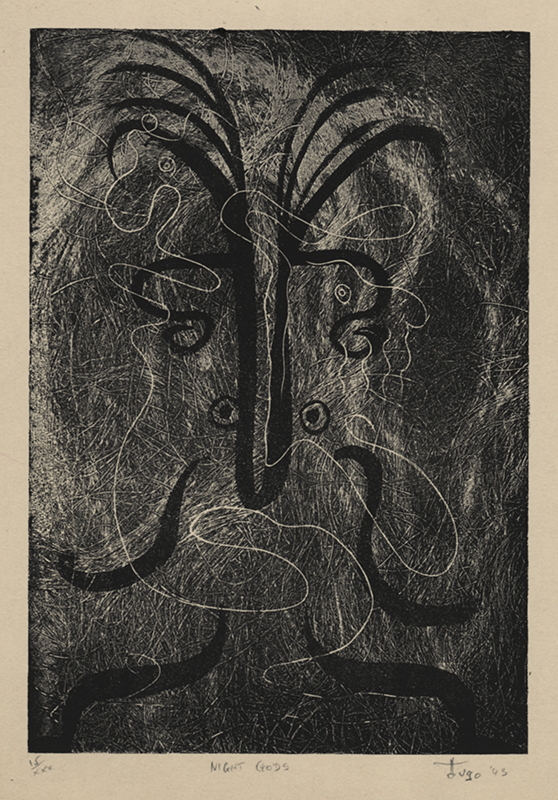
19th, 20th & 21st Century Fine Prints
707-546-7352 · fax 707-546-7924 · web: www.annexgalleries.com · email: artannex@aol.com
Night Gods by Ian Hugo

Night Gods
Ian Hugo
Night Gods
Ian Hugo
1898 - 1985 (biography)Though editioned at 30 Hugo's printing records indicate that he only printed 10 impressions, (though this is numbered "15") each varying in the depth of the blacks and on various papers. The copper plate for "Night Gods" is in the collection of the Museum of Modern Art (MoMA), New York. "Night Gods" was one of three Hugo works included in the important MOMA exhibition of August 1944 - "Hayter and Atelier 17."
Hugo scratched the aquatinted plate surface with something rough, perhaps sandpaper, that creates a web of swirling white lines on the composition. He further engraved sinuous white lines that project forward from the background and reinforced the aquatint with engraved black lines. The composition itself evokes many emerging surreal, dreamlike images - nightmares?
Ian Hugo was born Hugh Parker Guiler in Boston, Massachusetts on February 15, 1898. His childhood was spent in Puerto Rico (a "tropical paradise") the memory of which stayed with him and surfaced in both his engravings and his films) but he attended school in Scotland and graduated from Columbia University where he studied economics and literature.
He was working with the National City Bank when he met and married author Anais Nin in 1923. They moved to Paris the following year where Nin's diary and Guiler's artistic aspirations flowered. Guiler feared his business associates would not understand his interests in art and music, let alone those of his wife, so he began a second life, as Ian Hugo. Ian and Anais moved to New York in 1939. The following year he took up engraving and etching, working at Stanley William Hayter’s Atelier 17, established at the New School for Social Research.
Hugo was one the the early printmakers to help establish the Atelier 17 in New York with Stanley William Hayter, who he had known in Paris. Hugo wanted to learn engraving so he could illustrate Anais Nin's books which they were self publishing.
Hugo began producing surreal images that often accompanied Nin's books. For Nin his unwavering love and financial support were indispensable, Hugo was "the fixed center, core...my home, my refuge" (Sept. 16, 1937, Nearer the Moon, The Unexpurgated Diary of Anais Nin, 1937-1939). A fictionalized portrait of Hugo appears in Philip Kaufman's 1990 film, Henry & June.
